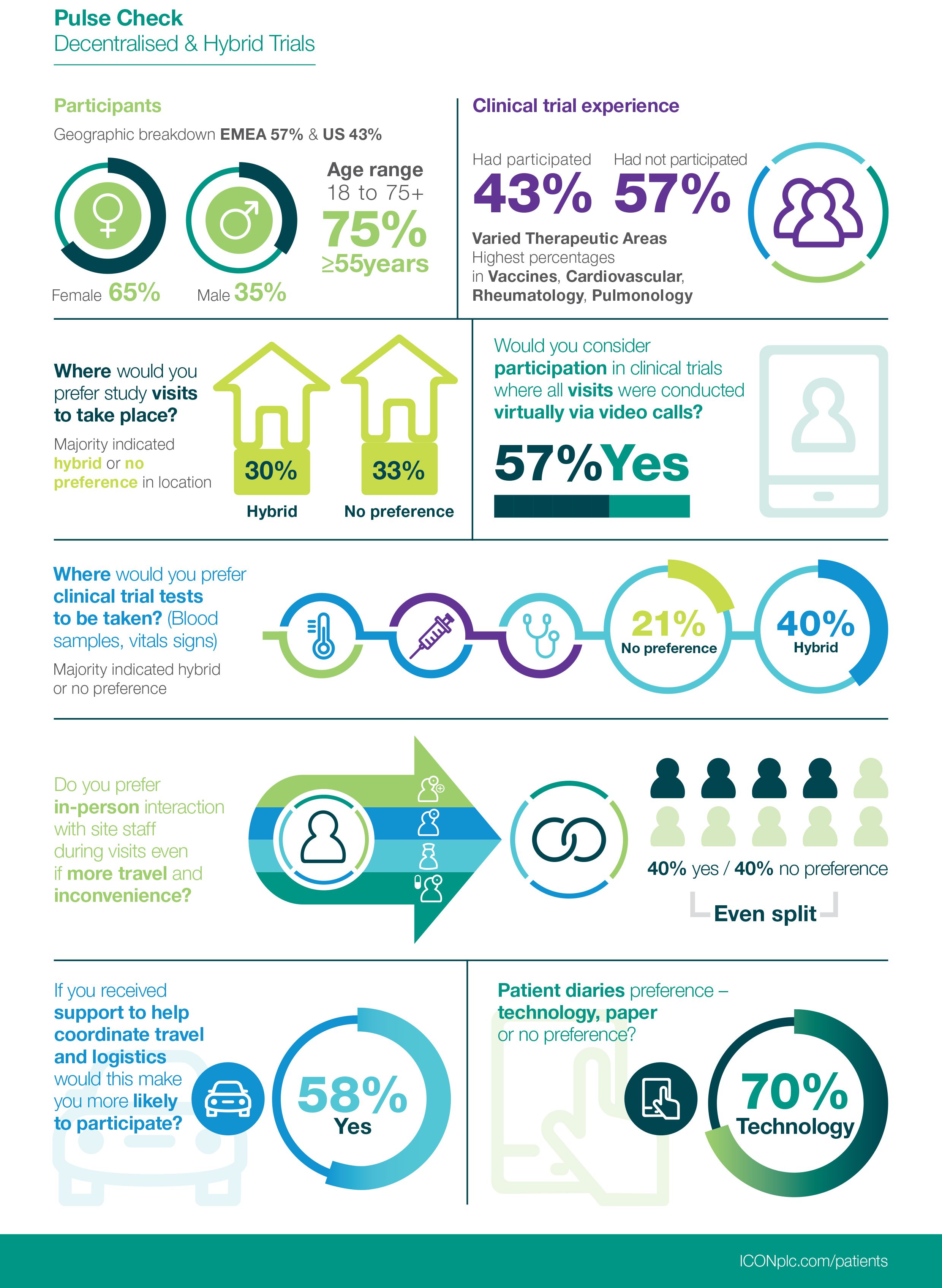Decentralized and Hybrid Trials
Click to enlarge.

Introduction
Decentralized and hybrid trials are widely discussed in the pharmaceutical industry and are already being deployed on some clinical studies. There are organizations that are convinced that it is the next big step in making clinical research more patient-centric and this will have a significant impact on the industry challenge of patient recruitment. But what does the patient think? With this objective in mind, a survey was conducted to get the patient view and find out whether bringing the trial to the patient could make a difference. We explored patients’ perceptions and preferences around what makes it easier for them to participate in clinical trials and to determine whether perception was reality.
Key insights
- Patients want options. Decentralized trials were attractive to some but not all patients in the survey. Hybrid trials are more likely to be of interest because the attachment with the healthcare professional and the support they provide remains intact.
- The patient relationship with site staff is important. In fact, since all of the patients involved in this study were connected with a site, whether that was through participation in a trial or just screening, this may have had an impact on how patients surveyed responded to some questions.
- Although patients are open to the idea of virtual trials with video calls, they still prefer face-to-face interaction for some or all visits. Therapeutic area can be a key factor affecting responses.
- While decentralized trials are appealing to some, travelling to a site is not a major barrier to all. Patients are willing to travel in order to have the opportunity to participate in a clinical trial, but as the 75% of respondents were over the age of 55 this may reflect that patients over this age have more flexibility to travel to sites.
- Patients prefer non-paper options for diaries, but the option of providing devices needs to be available for those who do not want to use their own or do not have them.
- Differences are not as pronounced in therapeutic areas as might be predicted. However, there were some therapeutic areas that showed more enthusiasm for decentralized or hybrid trials. Dermatology respondents consistently demonstrated a tendency to prefer or be open to remote options and had the highest preference to use their own smart phone. Neurology patients showed similar tendencies.
- Age considerations cannot be taken for granted. When looking further at the data within specific age groups, the 18–24-year-old group tended to prefer on-site, face-to-face interaction while the 25–34-year-old group was the most open to remote visits and activities, with a steady decline thereafter with increasing age.
- The provision of free services for coordinating travel arrangements or other logistics was important for all age groups in making them more likely to consider participation in a clinical trial.
Conclusion
The industry, sponsors, and sites need to connect and align with patient needs if they really want to improve the patient experience and make the clinical trial truly patient-centric. It is advisable to have the flexibility to customize options from trial to trial, taking into account the study design aspects for example; frequency of visits, complexity, and longevity of study and the patient population criteria such as; age, geography, and disease state.
The patient perspective on clinical trial participation may differ from what is generally expected at an industry level. We need to ask the patients what they want, provide choices for them, and move at their pace rather than move too quickly, increasing the challenges and complexities of participation. Moving too fast could mean slower adoption in the long run.
Gretchen Goller, MSW, global head, Patient Recruitment & Retention Solutions, ICON plc
Kristin Kinlaw, director of communications, PMG Research Inc.
The results of this research were first presented at the Global Site Solutions Summit, held in Hollywood, FL, USA, 11–13 October 2019.
Methodology
A web based survey was sent via e-mail to patients listed in the ICON owned Global Site Network Databases: 55,220 patients in the PMG Research Database (North America) and 33,000 patients in the MeDiNova Database (EMEA). The survey was also promoted externally via social media and was open for 3 weeks. Number of responses: 4,086.
Cell and Gene Therapy Check-in 2024
January 18th 2024Fran Gregory, VP of Emerging Therapies, Cardinal Health discusses her career, how both CAR-T therapies and personalization have been gaining momentum and what kind of progress we expect to see from them, some of the biggest hurdles facing their section of the industry, the importance of patient advocacy and so much more.